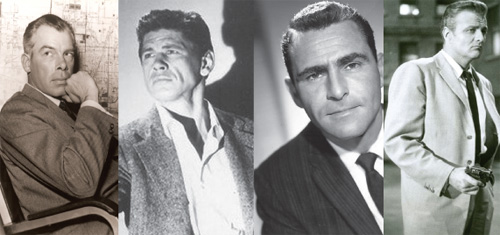arts@sfbg.com
FILM One of the longest and most unsung stretches of film noir’s half life as an enduring aesthetic sensibility has played out on television. From such former Nick at Night staples as Dragnet and Alfred Hitchcock Presents, to The Twilight Zone, to the neo-noir of Twin Peaks, and more recently, AMC’s drama The Killing, TV has long been home to those lawbreakers, revenge-seekers, and poor souls tormented by unexplained phenomena and sinister plots who once populated the black and white cinematic pulp of the 1940s.
In fact, Hollywood’s fingerprints are all over “TV Noir,” a highly detailed survey of the various types of malfeasance and mystery one could find on television sets during the medium’s golden age. The series’ seven nights of double bills, which kick off at the Roxie Fri/30, are packed with small screen rarities that frequently feature big Hollywood names (or soon-to-be big names) behind or in front of the camera for episodes of now forgotten shows with catchy titles such as Suspense, Danger, Checkmate, and Tales of Tomorrow.
Series curator and Roxie resident noir expert Elliot Lavine has dug deep, unearthing such treasures as Blake Edwards’ unsold 1954 pilot for Mike Hammer, a series that was to be based on Mickey Spillane’s famous hard-boiled detective, which screens opening night. Things get more highbrow with Saturday night’s showcase of “Great Directors.” The aforementioned Hitch is present, directing and producing the tense Cornell Woolrich-inspired “Four O’Clock” from his program Suspicion, which stars E.G. Marshall as a clockmaker who becomes the unwilling victim of his plot to blow up the wife he thinks is cheating on him. I doubt you will squirm through a tenser five minutes than during the episode’s penultimate scene, which showcases Hitchcock’s uncanny ability to manipulate the viewer’s emotions through editing. Also of note is 1951 Danger episode “The System,” an early scorcher by a pre-Hollywood Sidney Lumet, who directs a terrific Eli Wallach.
Of course, a survey of the darker side of the small screen would be incomplete without Rod Serling. Serling, who had catapulted his TV career with Kraft Television Theater’s live 1955 live broadcast of his screenplay Patterns, was in high demand and turning out top quality work pre-Twilight Zone, as evinced by the John Frankenheimer-directed 1958 episode of Playhouse 90, “A Town Has Turned to Dust,” which confronts racial prejudice in a poor, drought-ridden town in a way that Mad Men really has yet to do.
Like “A Town,” the other two Serling-scripted episodes in “TV Noir,” “Nightmare at Ground Zero” (a live drama from 1953) and “The Arena” (1956, from Studio One), hold up a cracked mirror to their times, reflecting growing anxieties over nuclear annihilation and the gradual erosion of the established political order.
These themes are given a less refined treatment in some of Lavine’s campier sci-fi selections showcased on Tuesday and Wednesday nights, in which extraterrestrial is more often than not an anagram for communist. Although, the 1958 pilot for Now is Tomorrow offers a more psychologically taut portrayal of the men entrusted to push “the button,” which is paired with the odd Edward R. Murrow-hosted docu-drama “The Night America Trembled” (1957, from Studio One) — a recreation of the night of Orson Welles’ infamous radio broadcast of War of the Worlds with a cameo by Welles himself. Five years later America would face down the threat of annihilation via broadcast during the Cuban Missile Crisis.
“TV Noir” also packs in a few outliers that aren’t to be missed. In the 1954 episode “Bond of Hate,” from British series The Vise, a bitter married couple realize their only recourse is to kill each other. Pamela Abbott’s performance as the harpy-like wife stands next to the late Ann Savage’s turn as the powder keg hitcher in Detour (1945) as an example of how to completely own nearly every second of screen time. Another must-see is the bizarre quiz show, The Plot Thickens (1963); it features an older, but still randy Groucho Marx as part of an “expert” panel that attempts to solve a short whodunit penned by Robert Bloch of Psycho fame. It even had its own mascot: a black cat named Lucifer, which guests were instructed to pass around for good luck. Also of note: television’s early years were also the golden age of sponsorship, and many of episodes in “TV Noir” include each show’s original commercials — including a very young Mike Wallace shilling for Revlon lipstick.
“TV NOIR”
Sept. 30-Oct. 6
Roxie Theater
3117 16th St., SF
(415) 863-1087

